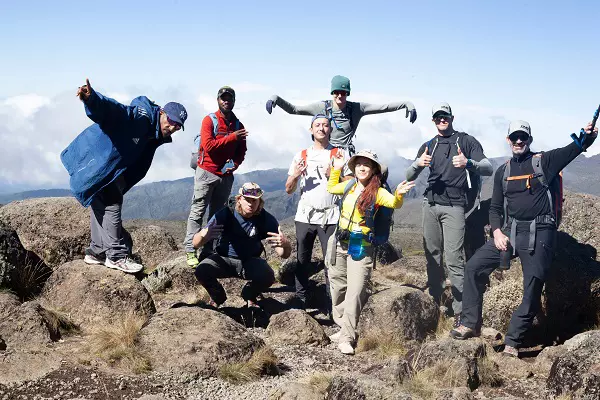Understanding Kilimanjaro’s Climate
Mount Kilimanjaro’s climate varies significantly with altitude and time of year, influencing trekking conditions. The mountain has five distinct climatic zones:
1. Cultivated Zone: The lower slopes, with a moderate climate, support farming and are lush with vegetation.
2. Rainforest Zone: Characterized by high humidity and frequent rainfall, this zone is rich in biodiversity.
3. Heather and Moorland Zone: Cooler and drier, this zone has unique flora adapted to harsh conditions.
4. Alpine Desert Zone: The environment becomes arid, with sparse vegetation and cold temperatures.
5. Arctic Zone: Near the summit, temperatures drop significantly, and the environment is characterized by glaciers and snowfields.
Understanding these zones helps in selecting the best month to climb Kilimanjaro based on expected weather conditions and personal preferences.
The Best Months to Climb Kilimanjaro
1. January to March
The period from January to March is often considered one of the best months to climb Kilimanjaro. During these months, the weather is typically stable, offering clear skies and moderate temperatures, which are ideal for trekking.
Key Benefits
- Stable Weather: Enjoy consistent weather with lower chances of rain.
- Clear Views: Take advantage of unobstructed views of the mountain and surrounding landscapes.
- Moderate Temperatures: Experience relatively mild temperatures, making trekking more comfortable.
- Fewer Crowds: These months see fewer climbers compared to peak periods, leading to a more serene experience.
Considerations
- Dusty Trails: Some routes may be dusty due to the dry conditions.
- Altitude Acclimatization: Ensure proper acclimatization to handle the higher altitudes effectively.
2. June to October
The months from June to October represent the peak climbing season and are often cited as the best month to climb Kilimanjaro due to their favorable weather conditions. This period falls within the long dry season, offering stable weather and excellent visibility.
Key Benefits
- Dry Conditions: Minimal rainfall reduces trail mud and enhances trekking comfort.
- Good Visibility: Clear skies provide stunning panoramic views of Kilimanjaro and the surrounding landscape.
- Best Weather: Enjoy the warm and dry conditions, which are ideal for high-altitude trekking.
- High Success Rates: Favorable weather conditions contribute to higher summit success rates.
Considerations
- Crowded Trails: Expect more climbers during these months, leading to busier routes and camps.
- Higher Costs: Peak season can lead to higher prices for permits and accommodations.
3. April and November
April and November are considered the shoulder months and are less popular for climbing Kilimanjaro due to the rainy season. These months experience the long rains (April) and short rains (November), which can affect trekking conditions.
Key Benefits
- Fewer Crowds: Experience less crowded trails and lower prices.
- Lush Vegetation: Enjoy the lush and vibrant landscapes resulting from the rains.
Considerations
- Rain and Mud: Prepare for rain and muddy trails, which can make trekking challenging.
- Visibility Issues: Cloud cover and rain may obscure views and affect overall experience.
Choosing the Best Month for Your Climb
Personal Preferences: When deciding on the best month to climb Kilimanjaro, consider your personal preferences and trekking goals:
- Weather Preferences: If you prefer stable, dry conditions, January to March or June to October are ideal.
- Crowd Tolerance: If you want to avoid crowds, consider the shoulder months of April or November.
- Budget: Peak months may come with higher costs, so planning in the shoulder seasons might offer cost savings.
Physical Preparation: Regardless of the month you choose, proper physical preparation is crucial. Kilimanjaro’s high altitudes and challenging terrain require good fitness levels and acclimatization to ensure a successful summit.
Guided Tours and Permits: Booking a guided tour and obtaining necessary permits in advance is essential for any climbing month. Guides provide valuable support and safety measures, enhancing your overall experience.
Conclusion
Selecting the best month to climb Kilimanjaro involves balancing optimal weather conditions, personal preferences, and practical considerations. January to March and June to October offer the most favorable weather, while April and November provide a quieter, though wetter, experience. By understanding the climatic patterns and planning accordingly, you can ensure a rewarding and successful Kilimanjaro adventure.









